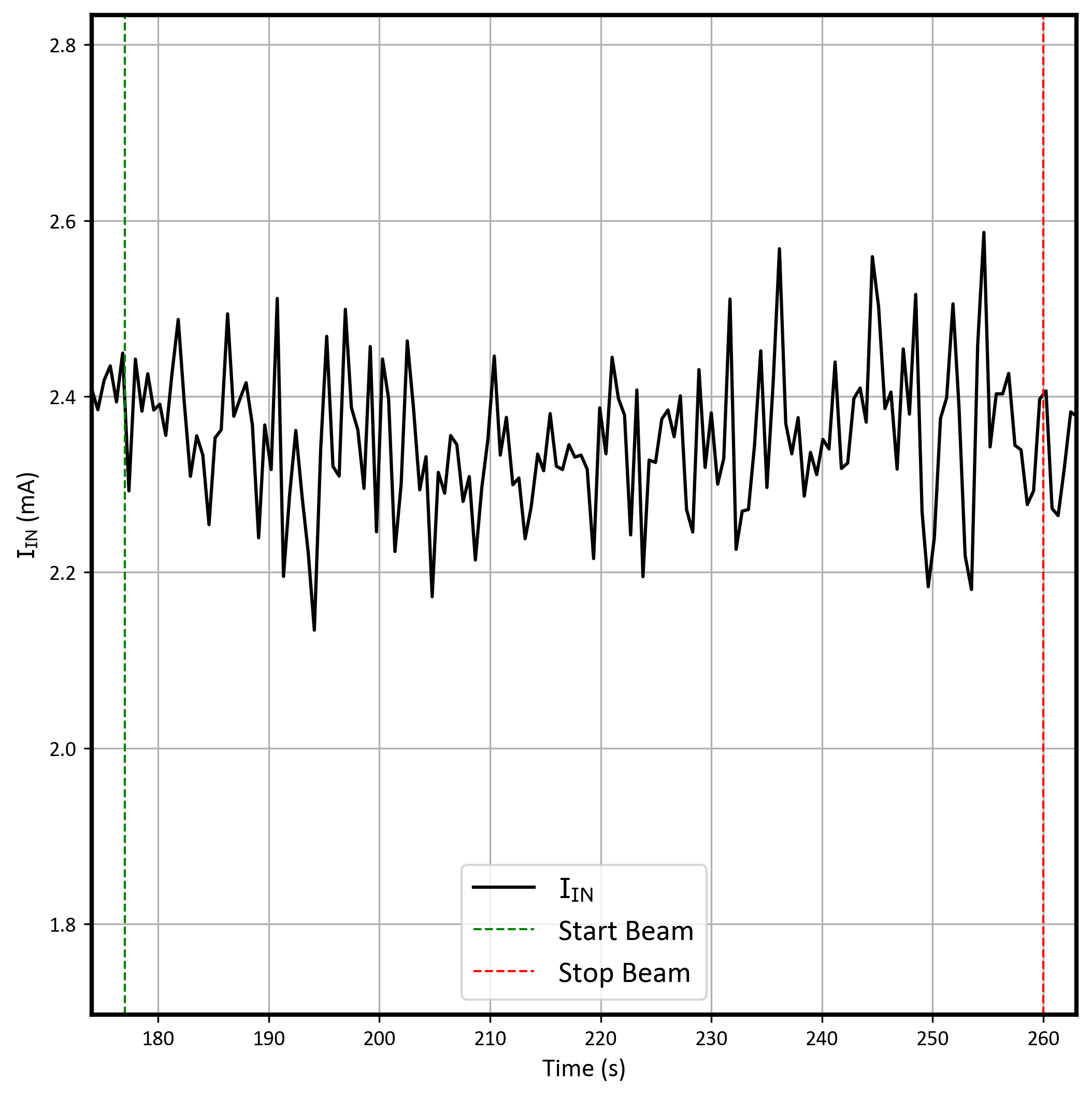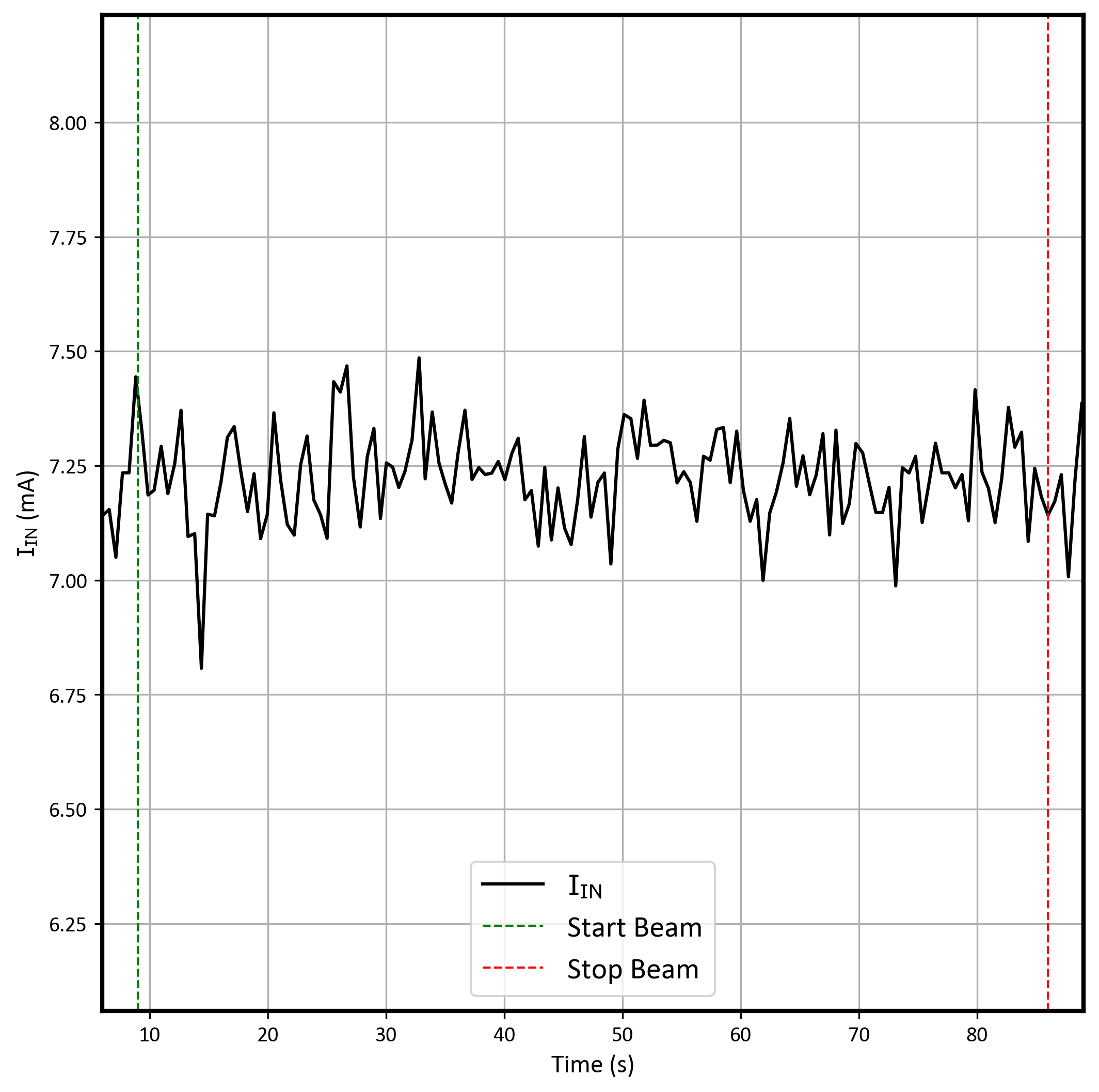SLVK099B March 2022 – September 2023 TPS7H5001-SP , TPS7H5002-SP , TPS7H5003-SP , TPS7H5004-SP
PRODUCTION DATA
- 1
- Abstract
- Trademarks
- 1 Introduction
- 2 Single-Event Effects (SEE)
- 3 Device and Test Board Information
- 4 Irradiation Facility and Setup
- 5 Depth, Range, and LETEFF Calculation
- 6 Test Setup and Procedures
- 7 Destructive Single-Event Effects (DSEE)
- 8 Single-Event Transients (SET)
- 9 Event Rate Calculations
- 10Summary
- A Total Ionizing Dose from SEE Experiments
- B References
- C Revision History
7.2 Single-Event Burnout (SEB) and Single-Event Gate Rupture (SEGR) Results
During the SEB and SEGR characterization, the device was tested at room temperature or approximately 25°C. The device was tested under the enabled and disabled mode. For the SEB-OFF mode the device was disabled using the EN pin by forcing 100 mV (using CH 0 of a E36311A Keysight PS). During the SEB and SEGR testing with the device in disabled mode, not a single OUTA (only trigger signal used) transient or input current event was observed.
The ion species used for the SEB and SEGR testing was Holmium (165Ho) at incident angle for an LETEFF = 75 MeV·cm2/mg. Flux of approximately 105 ions/cm2·s and a fluence of approximately 107 ions/cm2 was used for the run. Run duration to achieve this fluence was approximately 2 minutes. The six devices (three for TPS7H5001-SP and one each for TPS7H5002/3/4-SP) were powered up using the recommended maximum voltage of 14 V. No SEB and SEGR current events were observed during the seven runs, indicating that the TPS7H500X-SP is SEB and SEGR-free up to LETEFF = 75 MeV·cm2/mg and across the full electrical specifications. Table 8-4 shows the SEB and SEGR test conditions and results. Figure 7-2 shows the current versus time for run #4 (Disabled) and Figure 7-3 shows the current versus time for run #6 (enabled).
| Run # | Device | Unit # | Ion | LETEFF (MeV·cm2/mg) | Flux (ions·cm2/mg) | Fluence (# ions) | Enabled Status |
|---|---|---|---|---|---|---|---|
| 4 | TPS7H5001 | 1 | Ho | 75 | 1.24 × 105 | 1.01 × 107 | Disabled |
| 5 | TPS7H5001 | 1 | Ho | 75 | 1.26 × 105 | 9.96 × 106 | Disabled |
| 6 | TPS7H5001 | 1 | Ho | 75 | 1.31 × 105 | 9.98 × 106 | Enabled |
| 7 | TPS7H5001 | 2 | Ho | 75 | 9.73 × 104 | 1 × 107 | Disabled |
| 8 | TPS7H5001 | 2 | Ho | 75 | 1.01 × 105 | 1 × 107 | Enabled |
| 9 | TPS7H5001 | 3 | Ho | 75 | 1.17 × 105 | 9.96 × 106 | Disabled |
| 10 | TPS7H5001 | 3 | Ho | 75 | 1.13 × 105 | 1 × 107 | Enabled |
| 76 | TPS7H5002 | 9 | Ho | 75 | 1.06 × 105 | 9.96 × 106 | Disabled |
| 77 | TPS7H5002 | 9 | Ho | 75 | 8.12 × 104 | 9.98 × 106 | Enabled |
| 78 | TPS7H5003 | 10 | Ho | 75 | 1.14 × 105 | 9.96 × 106 | Disabled |
| 79 | TPS7H5003 | 10 | Ho | 75 | 1.15 × 105 | 9.95 × 106 | Enabled |
| 80 | TPS7H5004 | 11 | Ho | 75 | 1.13 × 105 | 1 × 107 | Disabled |
| 81 | TPS7H5004 | 11 | Ho | 75 | 1.14 × 105 | 1 × 107 | Enabled |
Using the MFTF method shown in Single-Event Effects (SEE) Confidence Interval Calculations, the upper-bound cross-section (using a 95% confidence level) is calculated as:
σSEB ≤ 5.27 × 10–8 cm2/device for LETEFF = 75 MeV·cm2/mg and T = 25°C.
 Figure 7-2 Current vs Time for Run #4
(Disabled) for the TPS7H5001-SP at T = 25°C
Figure 7-2 Current vs Time for Run #4
(Disabled) for the TPS7H5001-SP at T = 25°C Figure 7-3 Current vs Time for Run #6
(Enabled) for the TPS7H5001-SP at T = 25°C
Figure 7-3 Current vs Time for Run #6
(Enabled) for the TPS7H5001-SP at T = 25°C